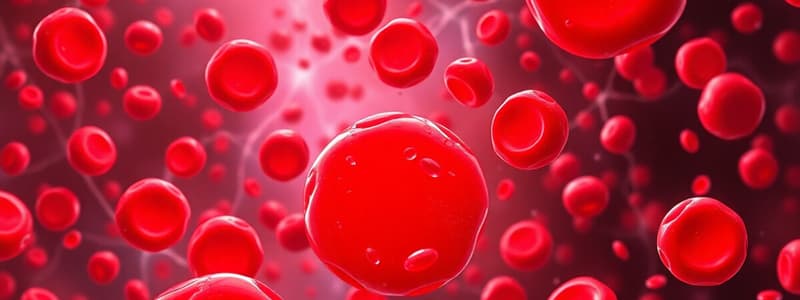Podcast
Questions and Answers
What percentage of blood is comprised of plasma?
What percentage of blood is comprised of plasma?
- 50%
- 45%
- 60%
- 55% (correct)
What is the average size of a red blood cell (RBC)?
What is the average size of a red blood cell (RBC)?
- 9 µm
- 6 µm
- 7.5 µm (correct)
- 8 µm
What is the primary color of aggregated white blood cells (WBCs)?
What is the primary color of aggregated white blood cells (WBCs)?
- Red
- White (correct)
- Green
- Yellow
Which of the following is a characteristic of red blood corpuscles (RBCs)?
Which of the following is a characteristic of red blood corpuscles (RBCs)?
What is referred to as microcytic anemia?
What is referred to as microcytic anemia?
Which of the following white blood cells has the highest percentage in the total leucocyte count?
Which of the following white blood cells has the highest percentage in the total leucocyte count?
What does leucopenia indicate about white blood cell counts?
What does leucopenia indicate about white blood cell counts?
Which type of leukocyte comprises 2-4% of the total leukocyte count?
Which type of leukocyte comprises 2-4% of the total leukocyte count?
What is the primary function of neutrophils?
What is the primary function of neutrophils?
Which granular leukocyte has a nucleus that is large and irregular?
Which granular leukocyte has a nucleus that is large and irregular?
What percentage range do eosinophils typically fall within in the leukocyte population?
What percentage range do eosinophils typically fall within in the leukocyte population?
Which type of lymphocyte is primarily responsible for cell-mediated immunity?
Which type of lymphocyte is primarily responsible for cell-mediated immunity?
What is the primary function of platelets?
What is the primary function of platelets?
Which statement accurately describes the size of monocytes?
Which statement accurately describes the size of monocytes?
What feature distinguishes basophils from other granular leukocytes?
What feature distinguishes basophils from other granular leukocytes?
What is a notable structural characteristic of platelets?
What is a notable structural characteristic of platelets?
Flashcards are hidden until you start studying
Study Notes
Blood
- The fluid of life, contained in the closed circulatory system.
- Composed of plasma (55%) and cells (45%).
- Cells include red blood cells (RBCs), white blood cells (WBCs), and platelets.
Red Blood Corpuscles (RBCs)
- Erythrocytes
- Shape: Biconcave discs, can appear as rouleaux in slow blood stream.
- Size: 6-9 µm (average 7.5 µm).
- Color: Single RBC is greenish yellow due to minimal hemoglobin, while stained sections appear red due to the large number of RBCs. Acidophilic with a pale center.
- Number:
- Males: 5-5.5 million /mm3.
- Females: 4.5 - 5 million /mm3 (decreased due to menstruation and female sex hormones).
- Structure & Adaptation to Function:
- Biconcave disc increases surface area for gas exchange.
- Plasticity allows squeezing through narrow vessels without rupture.
- Selective permeability facilitates the exchange of oxygen and carbon dioxide while retaining hemoglobin.
- Absence of nucleus and organelles allows for more space to accommodate hemoglobin for gas exchange.
- Contains carbonic anhydrase for transporting CO2 from tissues to the lungs.
Abnormalities of RBCs
- Abnormal Shape
- Spherocytosis
- Abnormal Size
- Normal 6-9 µm
- Microcytic Anemia
- Macrocytic Anemia
- Abnormal Number
- Oligocythemia (Anemia)
- Polycythemia
- Abnormal Color
- Hypochromic
- Normochromic
- Hyperchromic
White Blood Cells (WBCs) (Leucocytes)
- True nucleated cells.
- Appear colorless individually, but aggregated WBCs appear white.
- Count: (4000-11000/mm3).
- Leucopenia: <4000.
- Leukocytosis: >11000.
Agranular Leukocytes
- Lymphocytes (20-25%): Important for immune responses.
- Monocytes (3-8%): Phagocytic cells.
- Basophils (0.5-1%): Involved in allergic reactions.
Granular Leukocytes
| Neutrophils | Eosinophils | Basophils | |
|---|---|---|---|
| Percentage | 60-75% | 2-5% | 0.5-1% |
| Size | 10-12 μm | 12-15 μm | 10-12 μm |
| Nucleus | Single, Segmented (2-5 segments) | Bilobed or horse-shoe shaped. | Large, Irregular. |
| Cytoplasm | Fine neutrophilic granules. | Large acidophilic refractile granules. | Obscured by cytoplasmic granules. |
| Function | Defense mechanism: Phagocytosis of bacteria, foreign bodies, leading to pus formation. | Anti-allergic action by phagocytosing Ag-Ab complex. Contains histaminase & sulphatase to destroy excess histamine and other allergy-causing substances. | Produce histamine & heparin during allergy. |
Non-Granular Leukocytes
| Monocytes | Lymphocytes | |
|---|---|---|
| Percentage | 3-8% | 25-30% |
| Diameter | 15 μm | 6-8 μm (B&T) |
| Nucleus | Large & pale. Kidney or horse-shoe shaped. | Dark. Rounded. |
| Cytoplasm | Abundant. Pale basophilic. | Little rim around nucleus. Pale basophilic. |
| Function | Migrate into connective tissue and become macrophages. | B lymphocytes: Responsible for humoral immunity. T lymphocytes: Responsible for cell-mediated immunity. |
Platelets (Thrombocytes)
- Structure: Cytoplasm covered with a membrane, no nucleus (not true cells).
- Counts: 150,000-400,000/mm3.
- Shape: Oval or rounded discs.
- LM:
- Outer pale blue part (hyalomere)
- Central granular part (granulomere)
- Origin: megakaryocyte.
- Function: Hemostasis (stopping bleeding).
- Serotonin: Vasoconstriction to reduce blood loss.
- Platelet aggregation (white thrombus): Adherence to injured vessel walls.
- Red thrombus (coagulation): Secrete Thromboblastin which activates prothrombin into thrombin, converting fibrinogen into a fibrin network, attracting RBCs, and closing the blood vessel to stop bleeding.
Studying That Suits You
Use AI to generate personalized quizzes and flashcards to suit your learning preferences.




